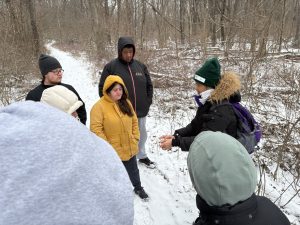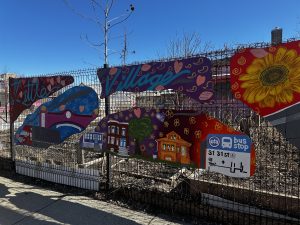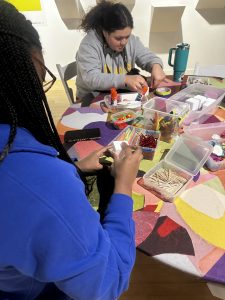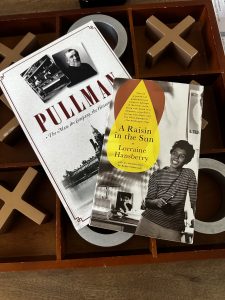The unflinching memorist Dorothy Allison writes, “Two or three things I know for sure, and one of them is that telling a story all the way through is an act of love.” A thorough and full accounting is indeed an act of love, and even an act of service.
Following a meaningful spring break service trip in northwest Indiana several weeks ago, I might amend Allison’s formulation a bit further: telling a story all the way through is an act of love and service…and so is attending to that story–listening compassionately, for understanding, and then figuring out what it means to hold and carry that story forward.
In a week spent criss-crossing northwest Indiana and south-southwest Chicagoland, we (Anna and Kat from the Institute for Leadership and Service) joined eight Valpo students on a journey to hear story after story–some ecology, some art, some history, some activism, some sociology – while participating in hands-on service projects related to our region’s grappling with environmental justice.
We visited National Parks, local museums, green spaces in Chicago, an urban garden in Gary, land preserved in trust in Valparaiso and Hammond, and a local farm while we interrogated questions of land access and power imbalances, the pros and cons of industrial development, food deserts and the burgeoning urban garden movement, local agriculture, and native and invasive species in conservation work.
Again and again, we witnessed this region’s beauty, potential, and fragility. It is a place of interlocking species and stories, held together by shared earth, water, and air–a place intimately shaped by the forces of nature as well as the people within it.
In last week’s CSL newsletter, Pastor Kate reflected on the profound “gift of hearing a community’s story [during a spring break service trip]–bearing witness to their tragedies and their triumphs.” We felt similarly humbled by that opportunity here in Indiana, as we learned and served alongside people doing all manner of good work in this corner of the world–from park rangers and “guerilla gardeners” to community artists and activists. In the spirit of valuing stories and perspectives, we offer below the reflective takeaways from some of the students we were fortunate enough to accompany on our early March trip.
Melanie
The regional service trip highlighted the importance of understanding stories both personal and historical. Every place we went to had its own background story, shaped by its people, environment, and history. Understanding these stories helped us connect with the land around us, fostering empathy, respect, and a deeper appreciation for diverse cultures and experiences. By learning about the challenges of the communities we visited, I better understand the broader issues they face and how we can contribute to positive change. Stories help us see the bigger picture and find meaning in the actions we take.

Student Leaders Melanie and Adam help with seed planting for this year’s Juneteenth celebration at Nichol’s Park in Midtown Gary.
Adam
Having this regional trip helped me to continue seeing the world in a different light. Doing hands-on service is nice, but it’s always harder to bring the lessons of a roof repair or hurricane relief work to NW Indiana. However, listening to stories about families within and just beyond VU’s walls resonated with me more easily, and also made me feel that I was having an impact in my community. It’s too easy for us to say “this is a problem, but it’s not happening where I’m from”, but this trip forced us to confront these questions in our own backyards.
Abby

Abby and other students explore the Indiana Dunes National Park and help remove invasive species to make space for an upcoming stream monitoring project.
This service trip really made me understand our environment in a different way, both culturally and naturally. I have always thought that gardening was hard to accomplish in Indiana, and that you need the perfect land to do so, but through learning about sustainable gardening, and the different ways you can re-plant food, I have been proven wrong. It was really interesting to participate in this kind of service trip, one that combined our current understanding of service, with one that sees service as learning, giving time instead of giving physical labor. Doing both helped me broaden my worldview, and I will take that forward to work that I do in my church and community.

Ximena gets her hands dirty while practicing winter sowing for the Juneteenth plant giveaway.
Ximena
As a first year student, I was anxious as to what my first service trip would be. I had never done outdoor service and it honestly scared me. However, this trip helped me see many ways one can do service. We started our trip by learning about our environment and history from not only Indiana but Illinois as well. Our group worked on looking past the “front cover” of cities and looking at its inside work. We learned about different viewpoints and how a community can overcome its struggles. Through this service trip, although we did do some physical labor, we learned to listen and carry the stories we learned and how that is also an act of service.
Dallas

Dallas helps with invasive plant removal and with packing totes full of locally grown produce for new moms in the WIC program.
Our Spring Break Service Trip was a very unique experience for me that helped to deepen my personal understanding of how different communities come together. Throughout the duration of our trip we learned about some of the business decisions that caused some of the largest environmental and social issues in Northwest Indiana and Chicago. Personally, I’m still amazed at how much damage can be done to one community in such a short period of time. Every area we visited challenged me to strengthen the value of listening to help learn from those we want to serve. It was truly moving to see how much it meant to them that we simply took the time to listen and understand their situation.

Jake helps with invasive plant removal at the Shirley Heinze Land Trust Meadowbrook Nature Preserve.
Jake
Coming from someone who isn’t from the area, there was a lot of learning to do on this trip. Our service trip focused on learning a lot. Each day left me with a greater understanding of the places we visited, because we took the time to learn about where we were, and the communities present. Learning about the unique geography of Northwest Indiana served us well, but it’s something that would benefit all service trips. Similarly, getting to connect with the people we were helping first rather than simply getting to work immediately enabled us to further understand the impact of our efforts. I strongly believe understanding and service go strongly together hand in hand after this; understanding the context behind the need for the service is just as important as the service itself.
Carolyn

Carolyn helps with plant removal to make way for an upcoming stream monitoring project.
It’s impossible to truly be of service without understanding the communities you’re serving and why you’re doing it. Without knowing the background behind the struggles a given community is experiencing, it’s impossible to address them effectively. During this trip, we were intentional about educating ourselves on the background behind the environmental issues northwest Indiana and Chicago are facing, and how they have historically impacted our area. It’s only in light of this knowledge that we were able to truly understand the context and importance of the current work that organizations are doing in our communities. By understanding why they’re responding the way they are, we were able to work with these organizations rather than simply for them to genuinely meet their needs.

Dunes Learning Center Fellow Lisa explains native and invasive species in the Indiana Dunes National Park, on our way to the Maple Sugar Time Festival at Chellberg Farm.

Murals created by local youth and families at the La Villita Park community garden in Little Village, Chicago.

Dallas and Jazzy create their own art as part of the Ordinary Wonders exhibit at the Lubeznik Center for the Arts in Michigan City.

Two ways to think about land, power, race, and industry in our area: the Pullman National Monument, and Lorraine Hansberry’s “Raisin in the Sun.” We experienced both live and in person this Spring Break.

ILAS Director, Anna Stewart, and Assistant Director, Kat Peters. We both feel so fortunate to have been on this trip with an amazing group of thoughtful, talented, and engaged students.